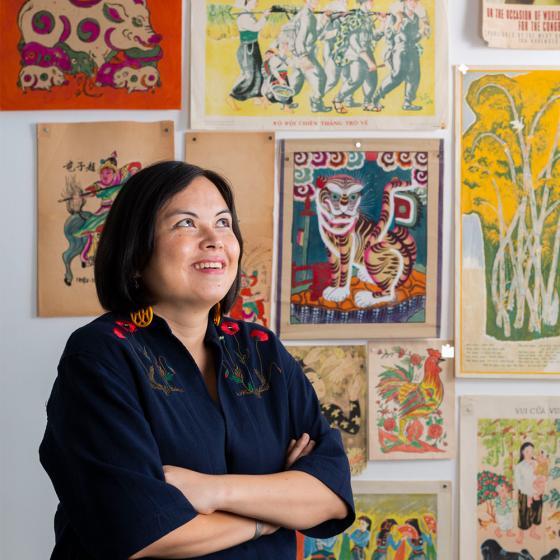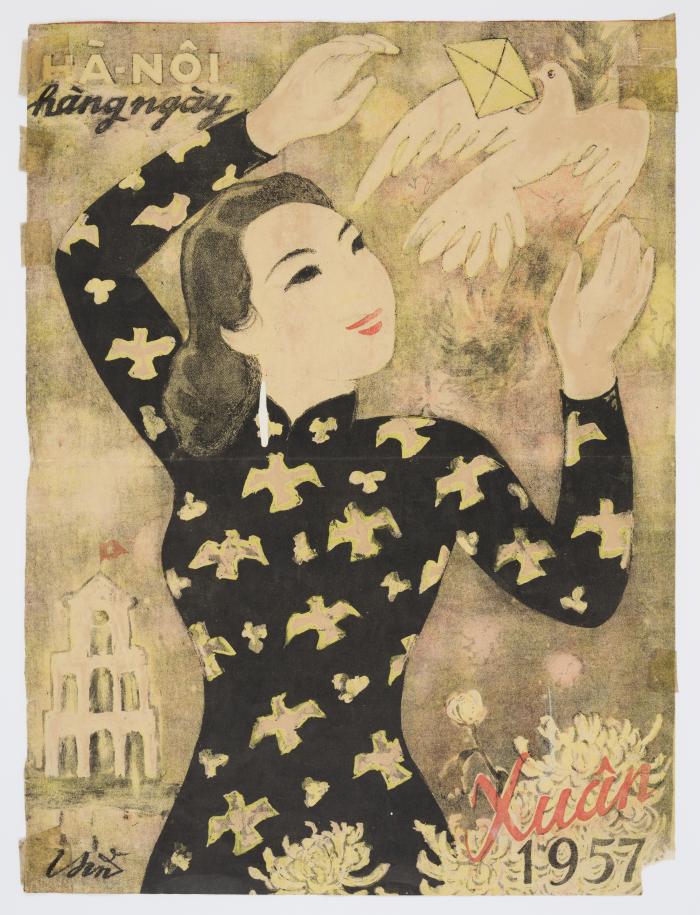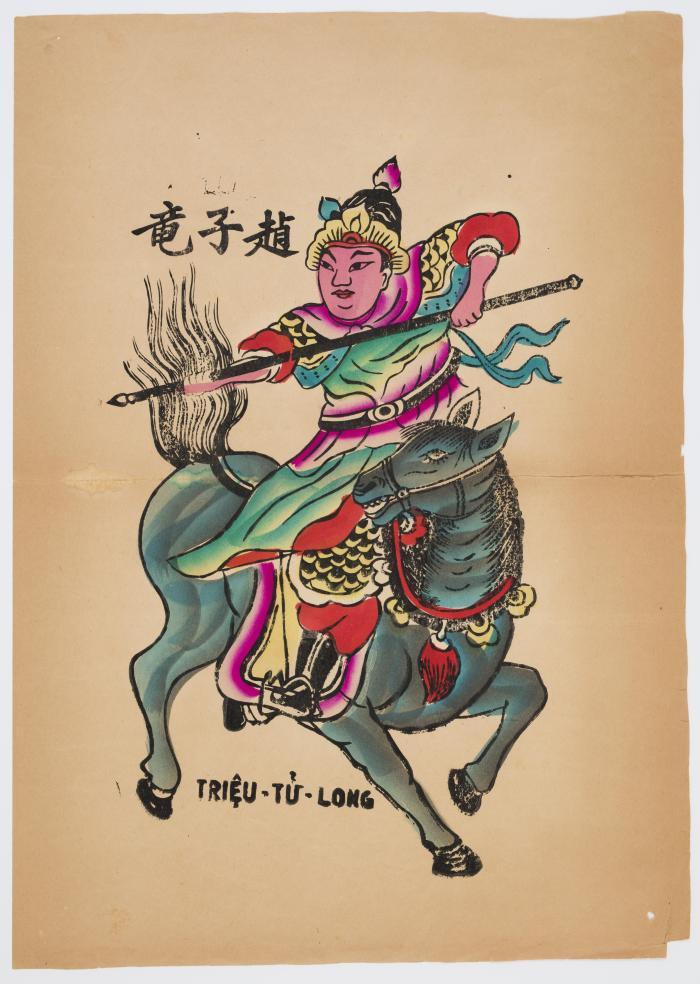In 1956, Australian writers Mona Brand and Len Fox boarded a cargo ship from Melbourne to Rangoon en route to Vietnam.
Though newly married, this was not their honeymoon; they were making their way to Hanoi to take up two postings with the North Vietnamese government to help its employees and others improve their English. Their friend Wilfred Burchett, a notable Australian journalist, had recommended them for the roles.
When Brand and Fox made up their minds to go, they had little idea of what to expect. Two years later, they found leaving ‘an emotional wrench’. ‘As the train left the station and the haunting sounds of one of our favourite lullabies filled the air, we both broke down,’ recalled Brand in her autobiography, Enough Blue Sky (1995).
Alongside their day-to-day work in Vietnam, the couple wrote and published several books, including Fox’s Chung of Vietnam (1957) and Friendly Vietnam (1958), and Brand’s Daughters of Vietnam (1958). The Library holds these books, the last two as part of the Dame Mary Gilmore collection. However, the Library has an even more astonishing legacy of Brand and Fox’s time in Hanoi: their enormous trove of Vietnamese art.
This collection largely comprises art posters and other ephemera. Most were commercially printed and sold cheaply, and these works were presumably much admired by Brand and Fox, as there are yellowed marks visible on the corners of many of the pictures from having once been taped to their walls.
Back in the 1950s, what did Australians know of Vietnam? This was the time, of course, before the country was thrust onto the world’s stage in the 1960s and 70s. Perhaps many of Fox’s contemporaries could relate to what he wrote in Friendly Vietnam: ‘Vietnam has always seemed to be a mythical country, a land that you hear about but do not visit.’
In a way, I relate to this as well. For the first part of my life, Vietnam was a country I would often hear about but did not visit — until I was almost 30 and finally made my way there for the first time. But Vietnam wasn’t a myth so much as the place where my family’s story began.
Given the turbulent events that eventually led us to a new life in Sydney, I began my research into these artworks with some discomfort. After all, Brand and Fox were active members of the Communist Party of Australia, and moved to Hanoi to support the newly formed government of North Vietnam under the leadership of Hồ Chí Minh. My parents, on the other hand, were born and raised in South Vietnam, and became staunch anti-Communists. But where possible I strive to overcome such stark ideological divides, guided by my own sense of curiosity and a desire for connection, which often leads to unexpected rewards.
For one thing, stumbling across these miraculously preserved works has allowed me to reach back into Vietnamese history in a way I hadn’t known was possible here in Sydney. Also, the more I read of Brand and Fox’s writing, the greater the sense of kinship I’ve felt. It’s clear they were sincere anti-war intellectuals who took great delight in learning about Vietnamese culture and history beyond the topical concerns of colonialism and war. Without much by way of Vietnamese language, their interactions and observations are impressive. Being activists for Aboriginal rights in Australia, it’s not surprising that they were both keenly interested in Vietnam’s many ethnic minorities; in the collection are several beautiful sketches of Hmong women.
Brand and Fox did not venture below the 17th parallel that separated North and South Vietnam during their time in Hanoi, and they viewed the regime of South Vietnam with immense skepticism. Yet, even though they ostensibly supported ‘the other side’, it is inspiring to read how intrepid they were, going off to live in Vietnam at a time when few Australians knew anything at all about the country.
Many works in the collection are by contemporary artists. Some had been trained in Western art traditions and had begun contributing to a modern style of Vietnamese art. But what I’ve found most fascinating are the examples of folk art. These popular artworks were produced — and continue to be produced — by artisans from Hanoi and surrounding villages. One set of woodcut paintings depicting tigers came from the Hàng Trô'ng and Hàng Nón streets of Old Hanoi, where Brand and Fox would have often walked.
There are also several examples of Đông Hồ folk woodcut painting, produced by a village in Bắc Ninh province, not far from Hanoi. These charming illustrations feature chickens, pigs, frogs, fish and other animals, all symbols of good wishes such as abundance, prosperity and honour. Many of these posters would have been used as decorations to celebrate the arrival of Tết, as the lunar new year was — and still is — the most important event on the Vietnamese calendar.
The colours in Vietnamese folk art were traditionally derived from natural sources, and the origins of the pigments described in Vietnamese Folk Paintings (2012) read like poetry:
The black was produced from bead-tree charcoal or ash from burnt bamboo leaves or straw. Verdigris was used for the blue. Red or yellow colours were created from Flamboyant or Royal Poinciana (Delonix regia) tree. A deep red colour was sourced from powdered red stone.
Looking at the collection, I’m reminded of how much Vietnam is a part of the Sinosphere, which is hardly surprising given the thousand years of Chinese colonisation. Among the mythological, religious and historical stories depicted in the artworks are great figures from Chinese history such as Trương Phi (Zhang Fei/張飛) and Triệu Tử Long (Zhao Yun/趙雲). My father would refer to these legendary military generals from the second and third centuries.
The country that Brand and Fox encountered, however, was not necessarily a nation mired in the deep past. Having ousted the French colonial forces, it was looking towards the future. In the collection are many examples of propaganda art, emotive works aimed at rallying people behind Communism and President Hồ Chí Minh. In Brand’s autobiography, she recalled the deep admiration she felt on meeting the president for the first time.
He greeted us warmly in English, asking if, being Australians, we found the weather too cold.
As compelling as these artworks are to me, the truth is I can’t help feeling an enormous sense of loss when I look at them. They are a reminder of the intangible gulf between Vietnam and Australia for someone like me. That grief is why I also felt particularly moved when I read Fox’s plea in Friendly Vietnam:
Is it too much to hope that since our countries have been brought close together by the advance of science, our people may come closer too — Australian mothers talking with Vietnamese mothers, Australian poets with Vietnamese poets, Australian music lovers with Vietnamese music lovers …?
Fox’s simple wish for Australia to become closer to Vietnam would come to pass; but he could not have predicted what else would occur after he asked that question more than 60 years ago. Back then, it was perhaps just beyond the imaginable that someone like me would one day be able to inhabit both of these identities — Australian and Vietnamese — at the same time.
Selected Vietnamese posters from the Mona Brand and Len Fox collection are on display in the Amaze Gallery.

She is currently undertaking a PhD at the Australian Institute of Health Innovation.





